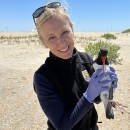Approaches to At-risk Conservation
To determine how we can conserve at-risk species, we tend to think of proactive steps in two major bundles…
1. Do we know why the species is in decline, and are we ready to work with others to implement activities, management actions or habitat protections to reverse the species decline? This is often referred to as implementation of conservation actions. When there is opportunity to collaborate with partners to implement conservation pro-actively, we can potentially reduce the likelihood of future petitions and/or be better prepared and informed if a petition is filed.
2. Is there something we do not know about the species, i.e., a data gap, such as migration route, host plant, etc. This is often characterized as an information need or information we need to collect prior to initiating efforts to address the species decline. Filling data gaps improves the Service’s ability to review a species when we evaluate them for listing under the ESA through the species status assessment report (SSA) and evaluation process.
For filling information needs, this can not only address data gaps if and when the Service is requested to review the species but also inform what conservation needs there could be so that we can work with partners to pro-actively implement them. This approach, in most cases, will not be linear, but rather tiered to navigate the evolving needs of the species.
Ultimately, we want to pursue active conservation for species where we have sufficient information to trust that our work will result in the intended benefit for the at-risk species. And if we don’t have that level of information, we want to identify and deliver science so that we can.
Partnerships are critical to this work, and if we want to have a meaningful impact, we know that we need our partners, both working with us on these actions and assisting us in identifying priority species. Ultimately, the at-risk conservation initiative depends on coordination among partners (e.g., States, local governments, Tribes, other Federal Partners, Non-government organizations, private landowners, and industry) to be successful.









